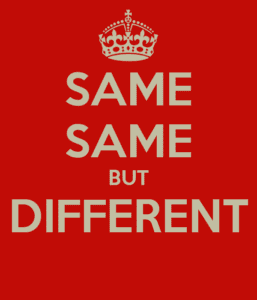Color claims for trademarks should in general be avoided. To be clear, there are situations when claiming color on a trademark registration application makes sense, but these situations are not common. What’s more, color claims might create issues in the future, if you stop using your trademark exactly as registered.
Claiming a color or colors as a feature of the trademark
When registering logos and stylized words as trademarks, brands have the option of claiming a color or colors as a feature of the trademark. If claiming color, a color image must be provided on the trademark registration application, at least in China and the United States. For example, the trademark below, registered in the United States by the Starbucks Corporation, claims the colors green, black, and white:
Brands also have the option of not claiming color. In those cases, a grayscale image must be provided. The trademark below is an example of a trademark registered without a color claim, also by Starbucks:
When a color claim is not made, trademark protection extends to the trademark irrespective of the color scheme on it. In other words, the registration for the trademark immediately above protects Starbucks’ exclusive right to use the mark not just in black and white, but also in green, black, and white, or pink, purple, and yellow, and so on. By contrast, the mark registered in color only protects Starbucks’ exclusive right to use the green, black, and white version.
For the Starbucks of this world, the distinction is often academic, as these brands will often register their key trademarks both with and without color claims, affording them the broadest protective scope available. For smaller businesses, however, budget considerations might make registering multiple versions of their trademarks unfeasible, in particular if they are also registering other marks, such as their English and/or Chinese names, slogans, or product names.
To be clear, registering a trademark with a color claim does not mean that other parties can do whatever they want with the mark as long as they change the color scheme. Sticking to the example at hand, if I open a coffee shop and place a red, orange, and yellow version of the Starbucks logo outside, it is almost certain that USPTO would not register “my” garish trademark, and that Starbucks would win a trademark infringement action against me.
What’s the issue with color claims then? Consider the following scenario, based on a situation one of our clients recently encountered.
Imagine you register your trademark in the United States making a red-and-black color claim. You then extend that protection to China via the Madrid System. Over time, you discard the red-and-black logo and start using a simpler version just in black. When it comes time to file a 5-year Declaration of Use for the U.S. trademark, you provide a specimen that shows the black logo.
In this situation, USPTO will consider, on a case-by-case basis, whether there has been a “material alteration” of the trademark. If in this case USPTO determines that there has indeed been a material alteration, it will reject the Declaration of Use, in turn leading to cancellation of the mark. Making things worse, because you used the Madrid System to obtain trademark protection in China, that protection depends on the original U.S. trademark registration for five years. A cancellation of the U.S. trademark registration would lead to the cancellation of the international registration upon which the extension to China depends. This would require you to “transform” the China trademark protections into a regular China trademark registration, leading to added costs and hassles.
Third party of your China trademark registration
Another possible hiccup involves a challenge by a third party of your China trademark registration. Imagine that you register a trademark in China (applying directly to the China National Intellectual Property Administration (CNIPA), not via the Madrid System), claiming the color blue. However, as you roll out your brand in China, your marketing team convinces you to use red instead, suggesting that color will resonate more with Chinese consumers. A few years later, a competitor files a cancellation action against your trademark, on the basis of non-use. You respond by submitting ample evidence of your use of the mark in red. CNIPA might accept that as evidence of use … but it might not.
As you can see, failure to continue using a trademark registered in color, in the exact form in which it was registered, can imperil your trademark rights. In the two scenarios above, the ultimate outcome might not be fatal, depending on the circumstances, but in both cases — likely unnecessary — color claims have the potential to lead to problems. What’s more, as China contemplates requiring certifications of use for registered trademarks every five years (see China Trademarks: Use It or Lose It for more information), the potential for color claim-related troubles is bound to grow.

























